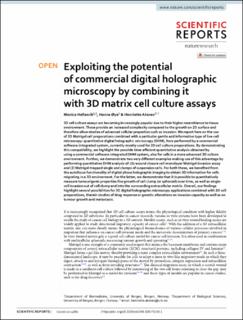| dc.contributor.author | Hellesvik, Monica | |
| dc.contributor.author | Øye, Hanne | |
| dc.contributor.author | Aksnes, Henriette | |
| dc.date.accessioned | 2021-05-18T10:56:22Z | |
| dc.date.available | 2021-05-18T10:56:22Z | |
| dc.date.created | 2020-09-23T14:58:32Z | |
| dc.date.issued | 2020 | |
| dc.Published | Scientific Reports. 2020, 10:14680 1-14. | |
| dc.identifier.issn | 2045-2322 | |
| dc.identifier.uri | https://hdl.handle.net/11250/2755432 | |
| dc.description.abstract | 3D cell culture assays are becoming increasingly popular due to their higher resemblance to tissue environment. These provide an increased complexity compared to the growth on 2D surface and therefore allow studies of advanced cellular properties such as invasion. We report here on the use of 3D Matrigel cell preparations combined with a particular gentle and informative type of live-cell microscopy: quantitative digital holographic microscopy (DHM), here performed by a commercial software-integrated system, currently mostly used for 2D cell culture preparations. By demonstrating this compatibility, we highlight the possible time-efficient quantitative analysis obtained by using a commercial software-integrated DHM system, also for cells in a more advanced 3D culture environment. Further, we demonstrate two very different examples making use of this advantage by performing quantitative DHM analysis of: (1) wound closure cell monolayer Matrigel invasion assay and (2) Matrigel-trapped single and clumps of suspension cells. For both these, we benefited from the autofocus functionality of digital phase holographic imaging to obtain 3D information for cells migrating in a 3D environment. For the latter, we demonstrate that it is possible to quantitatively measure tumourigenic properties like growth of cell clump (or spheroid) over time, as well as single-cell invasion out of cell clump and into the surrounding extracellular matrix. Overall, our findings highlight several possibilities for 3D digital holographic microscopy applications combined with 3D cell preparations, therein studies of drug response or genetic alterations on invasion capacity as well as on tumour growth and metastasis. | en_US |
| dc.language.iso | eng | en_US |
| dc.publisher | Nature Research | en_US |
| dc.rights | Navngivelse 4.0 Internasjonal | * |
| dc.rights.uri | http://creativecommons.org/licenses/by/4.0/deed.no | * |
| dc.title | Exploiting the potential of commercial digital holographic microscopy by combining it with 3D matrix cell culture assays | en_US |
| dc.type | Journal article | en_US |
| dc.type | Peer reviewed | en_US |
| dc.description.version | publishedVersion | en_US |
| dc.rights.holder | Copyright The Author(s) 2020 | en_US |
| dc.source.articlenumber | 14680 | en_US |
| cristin.ispublished | true | |
| cristin.fulltext | original | |
| cristin.qualitycode | 1 | |
| dc.identifier.doi | 10.1038/s41598-020-71538-1 | |
| dc.identifier.cristin | 1832644 | |
| dc.source.journal | Scientific Reports | en_US |
| dc.source.40 | 10:14680 | |
| dc.relation.project | Norges forskningsråd: 249843 | en_US |
| dc.identifier.citation | Scientific Reports. 2020, 10, 14680. | en_US |
| dc.source.volume | 10 | en_US |

